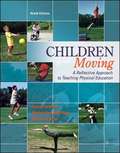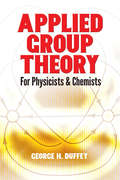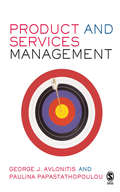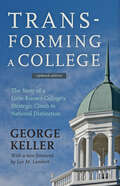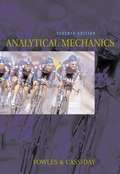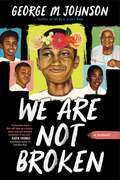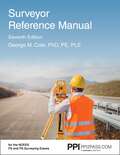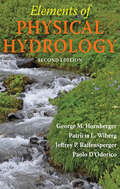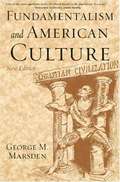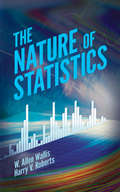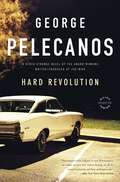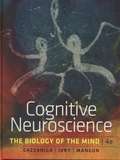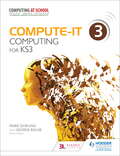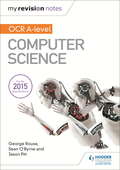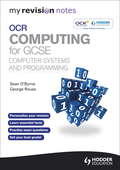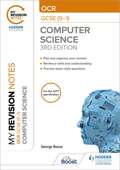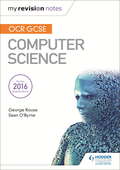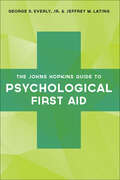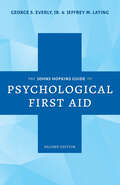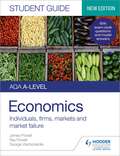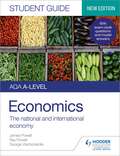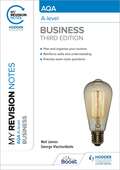- Table View
- List View
Children Moving: A Reflective Approach to Teaching Physical Education
by George Graham Shirley Ann Holt/Hale Melissa ParkerThe authors of Children Moving, however, recognize that each child is unique. One size does not fit all! Thus, Children Moving guides you in the process of learning to teach a curriculum that is differentiated for a range of skill abilities and fitness levels. If all children were the same, we would be able to package a curriculum with the same games and the same gymnastic stunts and dances you would do with all of the children as if they were identical. Children Moving, on the other hand, introduces you to the reflective approach--a process of teaching that provides the background for you to adapt, adjust, and modify lessons so they are interesting and worthwhile for all of the children you teach--from the lowest to the highest skill and fitness levels. The ultimate goal, of course, is to guide youngsters in the process of becoming physically active for a lifetime.
Applied Group Theory: For Physicists and Chemists (Dover Books on Physics)
by George H. DuffeyThis text introduces advanced undergraduates and graduate students to symmetry relations by means of group theory. Key relationships are derived in detail from first principles. Rather than matrix theory, the treatment employs algebraic theory in deriving the properties of characters and projection operators. This approach is customarily employed in quantum mechanics courses and makes the connection to group structure clearer. Cayley diagrams illustrate the structure of finite groups. Permutation groups are considered in some detail, and the special methods needed for continuous groups are developed.The treatment's broad range of applications offers students assistance in analyzing the modes of motion of symmetric classical systems; the constitutive relations in crystalline systems; the modes of vibration in molecules; the molecular orbitals of molecules; the electronic structures of atoms; the attendant spectra; and fundamental particle multiplets. Each chapter concludes with a concise review, discussion questions, problems, and references. 1992 edition.
Psychosocial Aspects of Disability (Fourth Edition)
by George Henderson Willie V. BryanThis new edition of Psychosocial Aspects of Disability strikes a balance of past, present, and future views of individual, family, societal, and governmental interaction and reaction to persons with disabilities. The past is presented in Part 1, Psychosocial Aspects of Disabilities, in which a view of the evolution of societal reactions to disabilities and persons with disability is presented. This perspective is important because it explains how some of the beliefs and attitudes toward disabilities and those who have a disability have developed. Additionally, Part 1 makes us aware from a historical perspective why persons with disabilities have been subject to certain types of treatment from family, friends, and society. Parts 2 and 3 provide discussion of present situations for persons with disabilities as they move toward better inclusion in society. Chapter 5 discusses the need for empowerment of persons with disabilities and how they can empower themselves. Chapter 6 discusses the need for better employment opportunities for persons with disabilities because this is a significant way of empowering persons with disabilities. Chapter 7 discusses federal legislation that has been developed to facilitate the empowerment of persons with disabilities. Part 4, Psychosocial Issues, to a large extent, represents the future for persons with disabilities. The chapters in this section discuss some disability issues that some persons with disabilities will encounter and/or by which they will be affected during the twenty-first century. Additionally, there is discussion of the need for persons with disabilities to attain the full human rights to which they are entitled.
Product and Services Management
by Paulina Papastathopoulou George J. Avlonitis`A text that successfully bridges the gap between academic theorizing and practitioner applicability because it uses multiple real-world examples/mini-cases of management techniques to illustrate the well-researched academic theoretical foundations of the book' - Creativity and Innovation Management `A complete and useful treatment of the domain of product and service decisions. This book is unique in its treatment, dealing with product and service portfolio evaluation, new product/service development and product/service elimination in an integrated manner. Enlivened by many mini-cases, the book provides a soup-to-nuts approach that will prove very attractive for students and be a valuable reference for managers as well. Highly recommended' - Gary L Lilien, Distinguished Research Professor of Management Science, Penn State University `Product and Services Management (PSM) is a welcome, up to date summary of the key issues facing firms in developing and refreshing their portfolios. The examples and cases bring the academic arguments clearly into focus and demonstrate the crucial role of PSM in leading the overall strategy of the firm' - Professor Graham Hooley, Senior Pro-Vice-Chancellor, Aston University, Birmingham `Managers responsible for and students interested in product portfolio decisions previously had to consult several sources for obtaining up-to-date information; books on new product development, articles on service development, readers on product management, and frameworks for product evaluation and termination. With the book Product and Services Management the reader obtains four-in-one. Avlonitis and Papastathopoulou reveal in a compelling and comprehensive manner why product decisions are the cornerstone of modern marketing and business, and illustrate the theory with numerous mini-cases from Europe and elsewhere. A must read for everyone with a passion for products' - Dr Erik Jan Hultink, Professor of New Product Marketing, Delft University of Technology This book provides a holistic approach to the study of product and services management. It looks at the key milestones within a product's or service life cycle and considers in detail three crucial areas within product management, namely product/service portfolio evaluation, new product/service development and product/service elimination. Based on research conducted in Europe and North America, this book includes revealing cases studies that will help students make important connections between theory and practice. The pedagogical features provided in each chapter include chapter introduction, summary, questions and a further reading section. Additional material for instructors include PowerPoint slides and indicative answers to each chapter's questions. This book is written for undergraduate and postgraduate students of business administration who are pursuing courses in marketing, product portfolio management, new product development and product policy.
Transforming a College: The Story of a Little-Known College's Strategic Climb to National Distinction
by George KellerGeorge Keller’s case study of Elon University’s transformation from a struggling college with a limited endowment into a top regional university is now available in paperback.Ten years after the publication of Transforming a College, Elon University continues to thrive as a school that reinvented itself and its community around the idea of inspiring and guiding students. George Keller’s now-classic account has been used as an inspiration and playbook for many other institutions. Available for the first time in paperback, this edition coincides with Elon’s 125th anniversary. A new foreword and afterword from Elon president Leo M. Lambert tell the rest of the story of the university’s ambitious agenda to position Elon as a top-ranked liberal arts university and a national leader in engaged teaching and learning.
Analytical Mechanics (Seventh Edition)
by Grant R. Fowles George L. CassidayThis textbook is intended for an undergraduate course in classical mechanics taken by students majoring in physics, physical science, or engineering.
Moral Politics: How Liberals and Conservatives Think (2nd edition)
by George LakoffIn this classic text, the first full-scale application of cognitive science to politics, George Lakoff analyzes the unconscious and rhetorical worldviews of liberals and conservatives, discovering radically different but remarkably consistent conceptions of morality on both the left and right. For this new edition, Lakoff adds a preface and an afterword extending his observations to major ideological conflicts since the book's original publication, from the impeachment of Bill Clinton to the 2000 presidential election and its aftermath.
We Are Not Broken
by George M JohnsonGeorge M. Johnson, activist and bestselling author of All Boys Aren't Blue, returns with a striking memoir that celebrates Black boyhood and brotherhood in all its glory. This is the vibrant story of George, Garrett, Rall, and Rasul—four children raised by Nanny, their fiercely devoted grandmother. The boys hold one another close through early brushes with racism, memorable experiences at the family barbershop, and first loves and losses. And with Nanny at their center, they are never broken. George M. Johnson capture the unique experience of growing up as a Black boy in America, and their rich family stories—exploring themes of vulnerability, sacrifice, and culture—are interspersed with touching letters from the grandchildren to their beloved matriarch. By turns heartwarming and heartbreaking, this personal account is destined to become a modern classic of emerging adulthood.
PPI Surveyor Reference Manual eText - 1 Year
by George M. Cole PhD, PE, PLSThe Reference Manual every Surveying examinee needs! George Cole&’s Surveyor Reference Manual, Seventh Edition (SVRM7) offers a complete review for the NCEES Fundamentals of Surveying (FS) Exam. This book is the most up-to-date, comprehensive reference manual available, and is designed to help you pass the NCEES FS exam the first time!Topics CoveredAlgebra, Basic Geometry, Trigonometry, CalculusField Data AcquisitionPlane Survey CalculationsGeodesy and Survey AstronomyCadastral and Boundary LawMappingSpecialty Surveying AreasAccuracy Standards Pair this reference manual with Solved Problems for a comprehensive review, and the Practice Exam to maximize your problem-solving efficiency and build exam-day readiness. This manual is included in all Fundamentals of Surveying Complete Exam BundleAbout the FS exam The NCEES FS Exam is your first step in becoming a professional surveyor (P.S.). The exam is a closed book computer-based exam containing 110 questions. You will receive and electronic reference at the exam.About the PS exam The NCEES PS Exam is a closed book computer-based exam containing 100 questions. You will receive and electronic reference at the exam.After you pass Surveyor Reference Manual, Seventh Edition (SVRM7) will serve as an invaluable reference throughout your surveying career. Key Features: 44 chapters provide an in-depth review of FS exam topics.Introduces many subjects covered on the Principles and Practice of Surveying (PS) exam.Enhanced coverage on aerial mapping.8 appendices containing essential support material.Over 300 practice problems to build your problem-solving skills.Over 120 common surveying terms defined in an easy-to-use glossary.Hundreds of equations, figures, and tables.Industry-standard terminology and nomenclature.Example problems that demonstrate how to apply the concepts presented.Binding: PaperbackPublisher: PPI, A Kaplan Company
Elements of Physical Hydrology
by George M. Hornberger Patricia L. Wiberg Jeffrey P. Raffensperger Paolo D'OdoricoThe most cogent textbook ever produced on the topic, this revised and expanded edition will be welcomed by students and professionals alike.Among the many diverse aspects of environmental science, none is more critical to the future of society and nature than water. Understanding the role of water on Earth and making good decisions regarding water conservation and hydrological hazards depends on learning the fundamentals of physical hydrology. This textbook, now in an expanded second edition, provides the clearest opportunity for students to absorb those fundamentals. Written at an introductory level, Elements of Physical Hydrology covers virtually every aspect of this subject, including:• The hydrological cycle• Water budgets at catchment to global scales • Spatial and temporal aspects of precipitation• Evapotranspiration• Fluid dynamics and the Bernoulli equation• Laminar and turbulent flows• Open channel flow • Flood movement through reservoirs and channels • Flood frequency analysis• Groundwater flow• Aquifer characterization• Land subsidence• Soil moisture dynamics• Flow in the unsaturated zone• Hydrologic controls on vegetation • Biotic controls on hydrological processes• Runoff generation from surface and subsurface sources• Catchment models• The water-food-energy nexus• The globalization of water• Impacts of changing climateLayering one topic upon the next, Elements of Physical Hydrology succeeds in moving from simple, easy-to-grasp explanations through equations and models in a manner that will leave students new to the topic eager to apply their knowledge. Professionals in related disciplines will also find this book ideal for self-study. Thoughtfully illustrated, carefully written, and covering a broad spectrum of topics, this classic text clarifies a subject that is often misunderstood and oversimplified.
Fundamentalism and American Culture (2nd edition)
by George M. MarsdenMany Americans today are taking note of the strong political force that is the religious right. Controversial decisions by the government are met with hundreds of lobbyists, millions of dollars of advertising spending, and a grassroots response.
The Nature of Statistics
by Prof. Harry V. Roberts W. Allen Wallis George P ShultzFocusing on everyday applications as well as those of scientific research, this classic of modern statistical methods requires little to no mathematical background. Readers develop basic skills for evaluating and using statistical data. Lively, relevant examples include applications to business, government, social and physical sciences, genetics, medicine, and public health. "W. Allen Wallis and Harry V. Roberts have made statistics fascinating." -- The New York Times "The authors have set out with considerable success, to write a text which would be of interest and value to the student who, not concerned primarily with statistical technics, must understand the nature and methodology of the subject in order to make proper use of its results." -- American Journal of Public Health and the Nation's Health "This book is a distinct and important contribution to the text literature in statistics for social scientists and should be given careful consideration by sociologists." -- American Sociological Review.
Hard Revolution: A Novel (Derek Strange and Terry Quinn Series #4)
by George PelecanosIn this epic showdown from "one of the best crime novelists alive" (Dennis Lehane), police officer Derek Strange hunts his brother's killer through a city erupting with rage.
Cognitive Neuroscience: The Biology of the Mind Fourth Edition
by Michael S. Gazzaniga Richard B. Ivry George R. MangunThe first textbook for the course, and still the market leader, Cognitive Neuroscience has been thoroughly refreshed, rethought, and reorganized to enhance students' and instructors' experience. The table of contents and the chapters themselves have been reorganized to improve the logical flow of the narrative, and the world renowned author team has kept the book fully up to date on the latest research in this fast moving field.
A History of Public Health
by George RosenGeorge Rosen's wide-ranging account of public health's long and fascinating history is an indispensable classic.Since publication in 1958, George Rosen's classic book has been regarded as the essential international history of public health. Describing the development of public health in classical Greece, imperial Rome, England, Europe, the United States, and elsewhere, Rosen illuminates the lives and contributions of the field's great figures. He considers such community health problems as infectious disease, water supply and sewage disposal, maternal and child health, nutrition, and occupational disease and injury. And he assesses the public health landscape of health education, public health administration, epidemiological theory, communicable disease control, medical care, statistics, public policy, and medical geography.Rosen, writing in the 1950s, may have had good reason to believe that infectious diseases would soon be conquered. But as Dr. Pascal James Imperato writes in the new foreword to this edition, infectious disease remains a grave threat. Globalization, antibiotic resistance, and the emergence of new pathogens and the reemergence of old ones, have returned public health efforts to the basics: preventing and controlling chronic and communicable diseases and shoring up public health infrastructures that provide potable water, sewage disposal, sanitary environments, and safe food and drug supplies to populations around the globe.A revised introduction by Elizabeth Fee frames the book within the context of the historiography of public health past, present, and future, and an updated bibliography by Edward T. Morman includes significant books on public health history published between 1958 and 2014. For seasoned professionals as well as students, A History of Public Health is visionary and essential reading.
Compute-IT: Student's Book 3 - Computing for KS3
by Mark Dorling George RouseCompute-IT will help you deliver innovative lessons for the new Key Stage 3 Computing curriculum with confidence, using resources and meaningful assessment produced by expert educators. With Compute-IT you will be able to assess and record students' attainment and monitor progression all the way through to Key Stage 4. Developed by members of Computing at School, the national subject association for Computer Science, and a team of Master Teachers who deliver CPD through the Network of Excellence project funded by the Department for Education, Compute-IT provides a cohesive and supportive learning package structured around the key strands of Computing. Creative and flexible in its approach, Compute-IT makes Computing for Key Stage 3 easy to teach, and fun and meaningful to learn, so you can:Follow well-structured and finely paced lessons along a variety of suggested routes through Key Stage 3Deliver engaging and interesting lessons using a range of files and tutorials provided for a range of different programming languages Ensure progression throughout Key Stage 3 with meaningful tasks underpinned by unparalleled teacher and student support Assess students' work with confidence, using ready-prepared formative and summative tasks that are mapped to meaningful learning outcomes and statements in the new Programme of StudyCreative and flexible in its approach, Compute-IT makes Computing for Key Stage 3 easy to teach, and fun and meaningful to learn. This is the third title in the Compute-IT course, which comprises three Student's Books, three Teacher Packs and a range of digital teaching and learning resources delivered through Dynamic Learning.
My Revision Notes OCR A level Computer Science
by George Rouse Sean O'Byrne Jason PittWith My Revision Notes you can: Take control of your revision: plan and focus on the areas where you need to improve your knowledge and understanding with advice, summaries and notes from expert authors Achieve your potential by applying computing terms accurately with the help of definitions and key words on all topicsImprove your exam skills by tackling exam-style and self-testing questions
My Revision Notes OCR Computing for GCSE Computer Systems and Programming
by George Rouse Sean O'ByrneUnlock your full potential with this revision guide which focuses on the key content and skills you need to know.With My Revision Notes for OCR Computing for GCSE, which perfectly matches the theory units of the specification, you can: Take control of your revision: plan and focus on the areas you need to revise, with advice, summaries and notes from authors Sean O'Byrne and George Rouse Show you fully understand key topics, by using specific case studies to add depth to your knowledge of computing issues and processes Apply computing terms accurately with the help of definitions and key words on all topics Improve your skills to tackle specific exam questions with the help of self-testing and exam-style questions and answers Get exam-ready with last-minute quick quizzes at www.hodderplus.co.uk/myrevisionnotes
My Revision Notes: OCR GCSE (9-1) Computer Science, Third Edition
by George RouseTarget exam success with My Revision Notes. Our updated approach to revision will help students learn, practise and apply skills and understanding. Coverage of key content is combined with practical study tips and effective revision strategies to create a guide students can rely on to build both knowledge and confidence.My Revision Notes: OCR GCSE Computer Science will help students:> Strengthen subject knowledge and key terms by working through clear and focused key content> Test understanding and identify areas for improvement with 'check your understanding' questions> Plan and manage a successful revision programme with the 'exam breakdown', 'countdown to the exams' and 'now test yourself' sections> Check answers to the practice questions against the answers provided> Enhance exam technique through exam-style questions and tips from leading author George Rouse
OCR GCSE Computer Science My Revision Notes 2e
by George RouseManage your own revision with step-by-step support from experienced teachers and examiners Sean O'Byrne and George Rouse. Use specific case studies to improve your knowledge of Computer Science. Apply terms accurately with the help of definitions and key words.-Plan and pace your revision with the revision planner-Use the expert tips to clarify key points-Avoid making typical mistakes with key expert advice-Test yourself with end-of-topic questions and answers and tick off each topic as you complete it-Get exam ready with last minute quick quizzes at www.hoddereducation.co.uk/myrevisionnotes
The Johns Hopkins Guide to Psychological First Aid
by George S. Everly Jr. Jeffrey M. LatingLearn the essential skills of psychological first aid from the expert who created the Johns Hopkins RAPID PFA method.Psychological first aid, or PFA, is designed to mitigate the effects of acute stress and trauma and assist those in crisis to cope effectively with adversity. PFA is designed to be applied in emergencies, including disasters and terrorist attacks. In this essential guide, George S. Everly, Jr., developer of the Johns Hopkins RAPID PFA method, and Jeffrey M. Lating, his collaborator in its implementation, describe the principles and practices underpinning this psychological model in an easy-to-follow, prescriptive, and practical manner. They explain the history of PFA and persuasively demonstrate its powerful versatility. Mental health practitioners can apply PFA in all settings. It can also be used as a public-health tool to address mental health needs following critical incidents and as a means for building community resilience.Aimed at mental health practitioners, all first responders, and global health disaster teams such as Médecins Sans Frontières and the World Health Organization, The Johns Hopkins Guide to Psychological First Aid is the first book to thoroughly explain RAPID PFA. RAPID, a unique theoretically grounded and evidence-based PFA method, follows a set of easily understood principles. In each chapter, Everly and Lating provide a step-by-step approach and include a key point summary to emphasize essential elements. A unifying case exemplifies each phase of the RAPID PFA model in an ongoing dialogue that presents ideal PFA responses, examples of common mistakes, and various outcomes.In addition to their counseling experience in Kuwait after the Gulf War and in New York City after the September 11 attacks, the authors have traveled nationally and internationally to teach the RAPID PFA method in numerous public health, fire, police, military, and faith-based settings. Beneficial to those with little or no previous mental health training, this book is an essential tool for people who want to learn, to practice, or to retain their ability to use psychological first aid effectively.
The Johns Hopkins Guide to Psychological First Aid
by George S. Everly Jr. Jeffrey M. LatingLearn the essential skills of psychological first aid from the experts—the creators of the Johns Hopkins RAPID PFA method.Psychological first aid, or PFA, is designed to mitigate the effects of acute stress and trauma and assist those in crisis to cope effectively. PFA can be applied in emergencies, including disasters, terrorist attacks, and the COVID-19 pandemic. In the second edition of this essential guide, George S. Everly, Jr., and Jeffrey M. Lating draw on their experiences in Kuwait after the Gulf War, in New York City after the September 11 attacks, and during the COVID-19 pandemic to describe the principles and practices of PFA in an easy-to-follow, prescriptive, and practical manner. Informed by current events, the second edition includes updated chapters as well as three completely new chapters on • cultural awareness• PFA considerations with children• the use of PFA to facilitate community mental health and resilienceAimed at mental health practitioners, first responders, and global health disaster teams such as Médecins Sans Frontières and the World Health Organization, but also beneficial to those with little or no previous mental health training, The Johns Hopkins Guide to Psychological First Aid thoroughly explains RAPID PFA. RAPID, a unique evidence-informed and evidence-based PFA method, follows a set of easily understood principles. In each chapter, Everly and Lating—who have traveled nationally and internationally to teach the RAPID PFA model in numerous public health, fire, police, military, business, and faith-based settings—provide a step-by-step approach and include a key point summary. A unifying case exemplifies each phase of the RAPID PFA model in an ongoing dialogue that presents ideal PFA responses, examples of common mistakes, and various outcomes.
AQA A-level Economics Student Guide 1: Individuals, firms, markets and market failure
by James Powell Ray Powell George VlachonikolisReinforce understanding throughout the course with clear topic summaries and sample questions and answers to help students target higher grades.This new edition Student Guide has been fully updated for 2020 and covers Theme 1: Introduction to markets and market failure (topics 1 - 8). With clear topic summaries of content needed for the exams, knowledge-check questions and samples of exam-style questions and answers throughout, this guide will help you prepare for exams with confidence.- Identify key content for the exams with our concise summary of topics- Find out what examiners are looking for with our Questions and Answers section- Test your knowledge with rapid-fire questions and answers- Avoid common pitfalls with clear definitions and exam tips throughout- Reinforce learning with bullet-list summaries at the end of each section
AQA A-level Economics Student Guide 2: The national and international economy
by James Powell Ray Powell George VlachonikolisReinforce your understanding throughout the course with clear topic summaries and sample questions and answers to help students target higher grades.This new edition Student Guide has been fully updated for 2020 and covers Theme 2: The national and international economy (topics 9 - 14).With clear topic summaries of content needed for the exams, knowledge-check questions and samples of exam-style questions and answers throughout, this guide will help you prepare for exams with confidence.- Identify key content for the exams with our concise summary of topics- Find out what examiners are looking for with our Questions and Answers section- Test your knowledge with rapid-fire questions and answers- Avoid common pitfalls with clear definitions and exam tips throughout- Reinforce learning with bullet-list summaries at the end of each section
My Revision Notes: AQA A-level Business: Third Edition
by Neil James George VlachonikolisOur updated approach to revision will help you learn, practise and apply your skills and understanding. Coverage of key content is combined with practical study tips and effective revision strategies to create a guide you can rely on to build both knowledge and confidence. My Revision Notes: AQA A-level Business: Third Edition will help you:- Plan and manage your revision with our topic-by-topic planner and exam breakdown introduction- Develop your subject knowledge by making links between topics for more in-depth exam answers- Improve subject-specific skills with an exam skills checkbox at the end of each chapter- Avoid common mistakes and enhance your exam answers with examiner tips- Practise and apply your skills and knowledge with exam-style questions and frequent questions with answer guidance online- Understand key terms you will need for the exam with user-friendly definitions and a glossary- Build quick recall with bullet-pointed summaries at the end of each chapter
